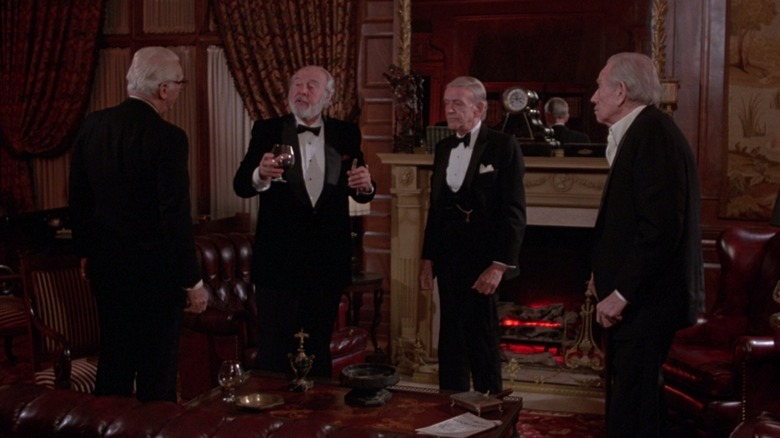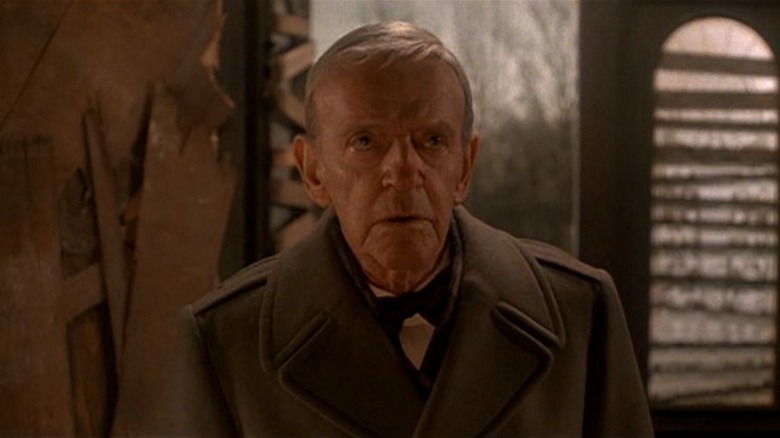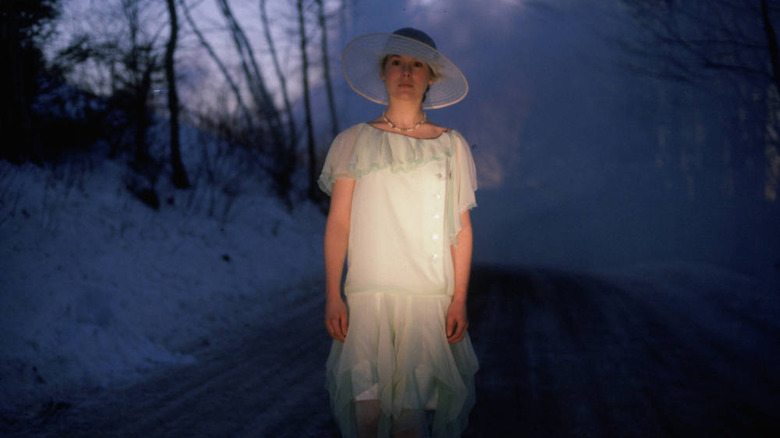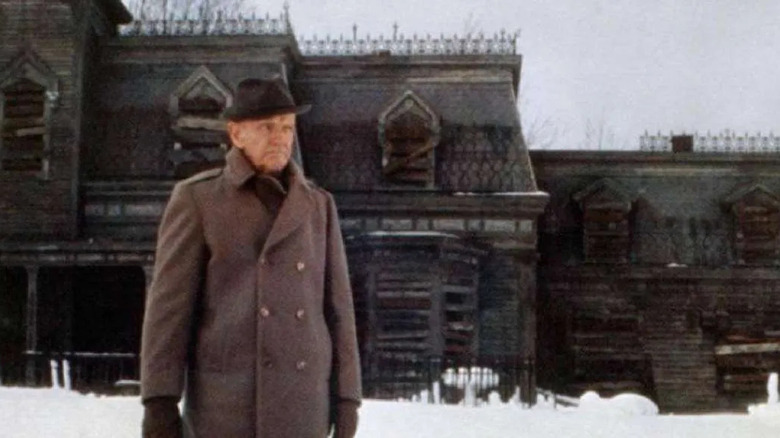Fred Astaire's Final Film Is A Gothic Gem Worth Watching
If one could have predicted what Fred Astaire's final motion picture would've been, they likely would've guessed it was a movie musical, or at least something pleasant and frothy. Yet while Astaire was, in his Hollywood heyday, a consummate song-and-dance man, the actor seemed interested in leaving that reputation behind him during the last act of his career.
Of course, Astaire was not so naive as to believe he could change his entire screen persona from his prior decades of film appearances, but during the mid-'70s and early '80s, he nonetheless chose projects and roles that didn't have any musical component to them and certainly didn't require dancing. After making his last musical in 1968 with "Finian's Rainbow," Astaire seemed determined to diversify his filmography, from being a part of the trapped ensemble of "The Towering Inferno" and tooling around Ireland helping lost people in "The Purple Taxi" to appearing as Starbuck's father in an episode of "Battlestar Galactica."
Yet few could have predicted that Astaire's final appearance on the big screen would be a fully-fledged horror film. Adapted from the best-selling novel by Peter Straub, 1981's "Ghost Story" is more than just an offbeat vehicle for Astaire; it's a chilly, dark, erotic (!!!) Gothic gem that's worth checking out for many reasons.
Astaire joins a murderer's row of classic screen actors in 'Ghost Story'
One of the standout aspects of "Ghost Story" the novel is the way Straub attempts to live up to the traditional elements of ghost stories. One of these elements is the tale revolving around a group of elderly characters who literally tell each other ghost stories by a fireplace, the better to distract themselves from the real-life ghost story that has haunted them their whole lives.
Such a setup meant that the "Ghost Story" movie had the opportunity to create an ensemble of seasoned actors, and director John Irvin went after the top of the list: as the AFI Catalog states, the likes of Jimmy Stewart and Henry Fonda were initially approached to star.
Although Stewart and Fonda wound up passing on the project, the film still ended up with a killer group of veteran actors: Melvyn Douglas, Douglas Fairbanks Jr., John Houseman, and of course, Astaire. Rather than having Astaire and his cheerful demeanor be the odd man out in a horror film, each of these performers has an inherent warmth to them which cleverly contrasts with the film's wintry setting and its dark story. The characters these men play are allowed to be sympathetic as the supernatural entity known as Eva/Alma (Alice Krige) threatens their lives while also being riddled with guilt over their past sins, which have quite literally come back to haunt them.
'Ghost Story' creates a spooky and surprisingly erotic mood
With such an accomplished cast and popular source material, it was up to Irvin and his other collaborators to make "Ghost Story" live up to its promise, and it does in many ways. Cinematographer Jack Cardiff (himself a veteran of Archers classics like "Black Narcissus" and "The Red Shoes") certainly makes the most of the film visually. As Roger Ebert wrote in his review upon the film's release in 1981, "Ghost stories should always begin as this one does, in shadows so deep that the flickering light of the dying fire barely illuminates the apprehensive faces of the listeners."
Ebert also praised the succinctness of screenwriter Lawrence D. Cohen's script, explaining how "Background is provided without being allowed to distract from the main event. The characters are established with quick, subtle strokes." The critic then offered his unequivocal stamp of approval: "This is a good movie."
Expectedly enough, "Ghost Story" has several eerie moments that capitalize on the film's pervasive mood of menace and dread. Yet what is perhaps even more interesting is how sexy the film is. Contrasting with the story of Astaire and the other men who make up the film's "Chowder Society," the movie follows the exploits of Don Wanderley (Craig Wasson), the son of Edward (played by Fairbanks Jr.) who becomes romantically entangled with Alma. Their scenes together are remarkably free and frank, rivaling another 1981 release, "Body Heat," for conflating desire and danger.
Although Astaire's character, Ricky, is never in a similarly compromising position, his brief interactions with his wife Stella (Patricia Neal) have more weight thanks to the film being so open and mature. It only serves to push "Ghost Story" further away from the more sanitized fare of Astaire's zenith.
Ghost Story was almost a creepier film
Although the general plot of "Ghost Story" is clear enough, there are a lot of odd characters and moments in the film's margins that remain unaddressed by the end. This includes the haunted house-dwelling duo of Gregory Bate (Miguel Fernandes) and Fenny Bate (Lance Holcomb) as well as the unnerving hints and allusions to just what Eva/Alma is.
Of course, these questions are answered within Straub's novel, which is a rather dense book of 483 pages. Cohen, who had previously adapted Stephen King's much more streamlined novel "Carrie" for Brian De Palma's 1976 film, does an impressive job paring down Straub's story but can't quite solve all the problems created by such simplifying.
Moreover, Irvin found himself in a tough spot when it came to the movie's tone and content. Universal Pictures was initially interested in having the film compete with the glut of gory slasher films that had been released throughout 1981, and a number of ghastly practical effects creations had been planned for the movie. Most of those were courtesy of effects makeup guru Dick Smith, who was fresh off of landmark horror effects movies like "Altered States" and "Scanners." Smith designed several incarnations of the demonic Eva/Alma, very few of which turn up in the final cut. Still, a few provocative stills remain, and articles such as the one published in the February 1982 issue of Cinefantastique at least provide some elaboration on what could've been an even more disturbing version of the film.
Despite those missing elements, "Ghost Story" retains its power to frighten and entertain, and if nothing else is an impressive showcase for Fred Astaire's range as a performer. It's only unfortunate that such a revelation came too late. Thus, "Ghost Story" is the only film where you can see Astaire stab a guy, survive a car crash, and fight a ghost. C'est la vie!



